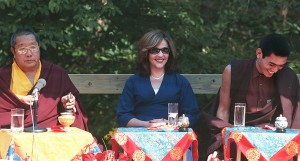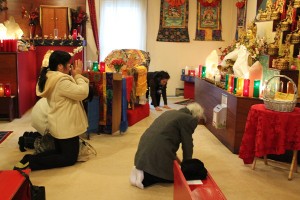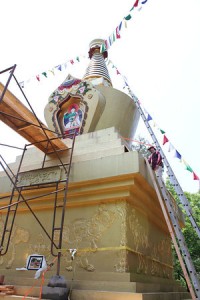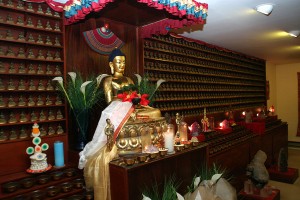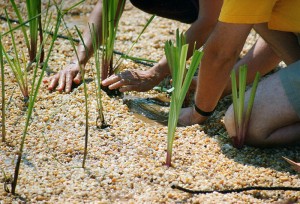Jetsunma Ahkön Lhamo and her sangha welcomed a new Shakyamuni Statue to Kunzang Palyul Choling in Poolesville, Maryland yesterday.
Activities at KPC
We Must Build To Survive And Thrive
The following talk was recorded during Jetsunma’s birthday celebration on October 12, 2018 at Kunzang Palyul Choling
Khenpo Tenzin Norgay Shares Short Bio Of Jetsunma Ahkon Lhamo
On the occasion of the 30th Anniversary of the enthronement of Jetsunma Ahkon Lhamo, Khenpo Tenzin Norgay shared the following biography:
How Will You Respond?
The following is an excerpt from a teaching by Jetsunma Ahkon Lhamo called “Experiencing the Hook of Compassion”
Sometimes we sort of wimp out. We want to be right. We want to have an issue. We want to be safe, without changing. We don’t want to change. So difficult to do. And meanwhile, all the teacher is really doing is calling the student from afar, sounding that note that is so like the student’s mind that it begins to bring forth this response that is in the student’s mind. And what they see is their own face, layer upon layer of their own face. Ultimately, if they practice devotion, they will see their true face, which is their nature. Now they’re only seeing the dust that is covering it. Now they’re only seeing the stuff that is on top of it. But all the teacher really does is sound the sound of their nature.
And something begins to happen. That sound is some kind of thing that you can’t even hear with your own ears, you know? You can’t even hear it. But it’s so powerful it can change the life of a student like that. Like instantly! And it can sustain that change. And it’s also so powerful that it can change an entire area. It can change a community. It can change the world. But it’s so subtle that you probably couldn’t even hear it with your own ears.
What is that? It is the greatest and the most gossamer force that there is, and that is the force of compassion— the bodhicitta. In practice the bodhicitta is compassion; it is kindness as we understand it. But its ultimate nature is the ultimate truth. It is the ultimate Buddha nature. And that is the sound that is being sounded, vibrationally cloaked to suit the students for whom the teacher has appeared. And it is for those students that the teacher has returned, that the teacher has appeared.
So it is like you. It is like you, and you should be strong. You should take responsibility for what comes up in your mind. You should know that this is your time, and you should respond through practice. Not through agreeing with yourself and saying that it’s okay to do this. It’s okay to have this hatred; it’s okay to be angry; it’s okay to be vengeful; it’s okay to be resentful; it’s okay to grieve; it’s okay to whatever. Why is that okay when you could be moving closer to your greatest hope?
So each student must have strength and understand what is happening to them. Do you, you who are responding, do you know what is happening to you? Do you really understand it? Do you really see its importance? And when the stuff comes up that comes up, and I know it comes up—the discursive thought, you know, the anger, the disagreement, the ‘well, I don’t know if I agree with that,’ you know, all these different kinds of thoughts—when that comes up in your mind, do you have the courage to get ahold of yourself? To take ahold of yourself and understand what is happening to you? That you are, in fact, seeing your own face. This is your resentment. This is your anger. This is your sadness. This is your needing to be independent. These are reflections; these are images of your mind. And in truth, so long as they keep you from pure practice and perfect surrender, from truly seeing with the help of your teacher, your own primordial face, these in fact are only obstacles to your practice that are coming up, and these are the form that they are coming up in.
So you can begin by giving thanks that they come up in such an easy-to-deal-with way. I mean you could have met your teacher and then got run over by a truck! That could have happened. That could have been a big obstacle. Well that was nice! But it didn’t happen, you’re still here! And you can right now begin to develop the courage to move forward without any hesitation.
Students respond with hope and fear. And sometimes, there is a lot of fear, isn’t there? Hope and fear, with anger, with restraint, with judgment, with discursive thought. They respond that way because it is their nature to do so. That is the nature of samsara, that is the nature of cyclic existence, and that is the nature of all sentient things. We have developed this habitual tendency of response in that way. Why should we suddenly change? Of course we’re still responding that way. We always do. Always.
The important difference is that suddenly now we have a choice. We can begin. We can respond through mindfulness. We can respond through practice. We can respond by recognizing, through courage, that this is our response due to our habitual nature. We can stand outside of this whole deeply reactive scenario, and instead of reacting with the hatred, instead of reacting with grief, instead of reacting at all, we can know, we can understand: This is my mind. That is my teacher. The only thing to do is to walk forward and to continue, to walk through the door. So simple. And yet, due to our strong reactions, so difficult.
Copyright © Jetsunma Ahkon Lhamo. All rights reserved
Offering the Miraculous
The following is an excerpt from a teaching given by Jetsunma Ahkon Lhamo during a “Good Heart Retreat“
There are some that may criticize the building of the Migyur Dorje stupa. I understand that it cost a couple of hundred thousand dollars. You might say, ‘Well, gee, if you’re going to spend a couple hundred thousand dollars, why don’t you feed the poor?’ Well, I feel like I am. I feel like that’s the point of the stupa. I begged and begged His Holiness for these relics and the ability to build the stupa because in this country there’s no place to go when you have no hope. There’s simply no place to go when all the doctors have told you they can’t help you. There’s no place to go when you’re at your last moments and maybe even the karma for this life has run out and you know that you haven’t really attended to your spiritual life. You know that you haven’t practiced very much. Or when your life is such that you got the ‘can’t fix-its’; don’t know how to put it back together again.
I know that in other places, in other lands, there are deeply inspiring religious pilgrimage places. I know that in Tibet almost all of the Tibetans, at one time or another, take some sort of major pilgrimage; and it’s a life changer. There are so many stories of pilgrimages turning out to be major healings. Where people will go to these holy places in which they have tremendous faith, where there are extraordinary relics there that are left by extraordinary Lamas, and healings take place that are miraculous.
I also knew that in this country there is AIDS which has been growing incrementally, cancer which is killing so many, and people constantly dying from all sorts of diseases that seem to be the afflictions of this day and time. There are so many diseases that we haven’t found any cures for, including simple mental unhappiness. Because of all this, I really wanted to offer this stupa to our community. What we have built here is, yes, at great expense, yes, at great effort; but also done with great joy. We have been able to gather together enough money, enough energy, and enough time to make this dream a reality. And now we have something here which over time, hopefully by word of mouth, hopefully by your good works and your good faith, the word will spread out that we have this amazing stupa here. Now anyone at any time, no matter what they have experienced as their spiritual path, if they’re ever down and out and without hope, can come here and make prayers. There is a potency to that pilgrimage. I’m hoping that it will become known that these same relics from Terton Migyur Dorje, these relics, of which there are pieces in different places of the world, not too many, but particularly in Tibet, have brought about amazing cures. I want people to know about this. I want them to come and feel better. To me, it’s like the ultimate soup kitchen, you know? You can offer this nourishment, this food, to your community.
So we went through the effort of building this thing, and thank you all for everything that you’ve done to make it possible—the work and the money, all of it—and now we have this tremendous gift to offer the community. To my way of thinking, this is one such group or community effort that we have made together in order to provide for and to nourish the community and make our hopes for the world more visible and more heard. That’s one way to do it. But I think at this point it’s time to move even beyond that.
Copyright © Jetsunma Ahkon Norbu Lhamo All rights reserved
Blessings on Chokkor Duchen 2017 at KPC
On Chokkor Duchen 2017 Jetsunma Ahkon Lhamo offered Refuge and Bodhisattva Vows to teens who have completed Bodhisattva Training available at KPC:
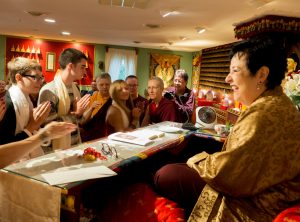
Refuge Vow
I take refuge in the Lama.
I take refuge in the Buddha.
I take refuge in the Dharma.
I take refuge in the Sangha.
Bodhisattva Vow
I dedicate myself to the liberation and salvation of all sentient beings. I offer my
body, speech and mind in order to accomplish the purpose of all sentient beings. I will return in whatever form necessary, under extraordinary circumstances, to end suffering. Let me be born in times unpredictable, in places unknown, until all sentient beings are liberated from the cycle of death and rebirth.
Taking no thought for my comfort or safety, precious Lama (Buddha), make of me a pure and perfect instrument by which the end of suffering and death in all forms might be realized. Let me achieve perfect enlightenment for the sake of all beings. And then, by my hand and heart alone, may all beings achieve full enlightenment and perfect liberation.
— Jetsunma Ahkön Lhamo
We Were Born to Do This
The following is a message recorded on June 1, 2013 as a message from Jetsunma Ahkon Lhamo to her students (audio file below):
This really has been the hardest time of our lives as a sangha, because we don’t know what the future is going to be. We don’t know whether we will stay together.
A sangha is a precious thing. It has to stay together. It’s like a family. When it is broken something precious is lost. It is tragic.
I just want to speak to my sangha, because right now we don’t have a building that we can use the way we normally would, but I want to remind you that we still have the land. So, don’t abandon it. We are coming back online pretty darn soon. Not soon tomorrow, not even soon next year, but soon. And it will be progressively better and better and better. So don’t give up. I haven’t. I would live in a tent if I had to, as long as I had a fence for my dogs.
I just want to say that we have to make this the best effort of our lives. We cannot say, “Oh I pay this much every month, and so I shouldn’t have to pay any more.” Or I pay this much every year, or whatever. You can’t say that and think that’s enough. It’s not. Not right now. That was enough before, and we counted on you. If you didn’t help us in the way that we’d agreed on way back in the past, then we wouldn’t have anything.
This was a group of people that stuck together for a long time; learned to love each other. Then of course because they are sentient beings, they learned to argue with each other. And as usual, we don’t even realize that we are doing it.
I hope to get your attention. I have had a hard time getting your attention lately. It is like trying to herd cats. And of course we all know that is impossible, because cats are cats. Could you not be a cat for a while, and learn how to work for the larger group, for the group of sentient beings that we are and the group of sentient beings that we serve? To work for all sentient beings ultimately. If we could just get back there, everything would come back. It is cause and effect.
We have been too selfish. I have broken it up the best I could by just giving everything away. Have you noticed? Many of you don’t even know. I hope you will pay attention. I hope you will wake up.
I am glad that people are having weddings and family things. I’m glad for all of you. I don’t have any of those things in my life at this point, but I am glad for all of you.
At this part of my life I feel like I have got to keep moving forward or it’s all on me. The truth of the matter is that no one person can do it, and it’s not all on me. So you have to help me figure this out. I am actually working hard every day. Not just sitting here trying to think it out. But talking to people who might be able to help us. So help me. I have helped you over the years. Why can’t you help me? Amen.
I hope you hear me. We were made to do this. I hope you hear me. We were born to do this, and it is hard, but I hope you hear me.
You can hear the message here: Messsage From Jetsunna
Copyright © Jetsunma Ahkon Norbu Lhamo All rights reserved
Utilizing the Antidote
The following is an excerpt from a teaching by Jetsunma Ahkon Lhamo called “The Lama Never Leaves”
Now it’s also said that the stupa has a mandala of enlightened activity around it the same as a living Buddha does. That is to say, that a stupa that is powerfully consecrated with relics, and consecrated by an enlightened lama who has accomplished the mantra, has a radius of about 100 miles of influence. Isn’t that amazing?
Yet, we are not keeping that strength going, that fire going. The power of the stupas will be, by definition of mind, diminished because our minds are not with them. So it’s a terrible, terrible frightful waste. It’s really like having all the lamas of the lineage across the street. Oh, we pride ourselves that we have robes and we can go places and we can do practices. Some of us even have the more advanced practices. We can stare at bindus and stuff like that. But if we don’t walk across the street and take care of the stupas, you can say we have no practice. You could say that. Because it’s like the lamas of the lineage are there, and no one is honoring them. We call them to our practice. We pray to the lamas of the lineage. We visualize them gathering in front of us, but we abandon them. And so what is this cartoon in the sky in front, when we have abandoned the actual Nirmanakaya form?
They say that the lama and also the stupas have this 100 mile radius, approximately, of activity. I built these stupas here because I was hoping that they would influence our government, but I don’t think that has happened as yet,. I could be wrong, but I don’t see it. So I’m wondering if I could prevail upon each and every one of you to take these stupas into your heart, to think of them as your guides, your objects of refuge and to honor them in the way that they should be honored so that the lamas through these magnificent stupas can carry out their enlightened activity. Because these stupas are an extension and an appearance of the Buddha’s enlightened activity.
It’s up to us to plant that firmly in the world, to make the roots deep and to keep the causes pure and untainted for future accomplishment and future happiness. There are so many stories in Buddhist teachings about particular practitioners that came to their own fruition through some slight, almost mindless, deed in the past concerning a stupa. I’m a terrible Buddhist storyteller because I forget the details and I get the punch lines wrong, but I’ll try. I’ll try to tell you a little bit of what I remember.
There is this one story, for instance, about a pig who was being chased by a dog. And the pig was a pig. He had been wallowing in mud, and he was all dirty. He had a muddy body and a muddy face and a muddy tail. And the dog thought, “Oh, I’m gonna’ get me some pork chops,” and started chasing the pig. And round and round this stupa they went. After they went round the stupa a few times, the pig smashed into the stupa accidentally and the mud from his body fixed a little crack in the stupa. That [pig] was reborn in Dewachen, or some enlightened paradise, because of that cause and immediately received teachings and the ability of accomplishment. He was reborn as a bodhisattva, and was given every means to accomplish; and accomplishment was gained. A pig! Accidentally! These stories are told to us as an indication of what you’re missing, of how amazing the merit is of caring for the body of the Buddha.
Conversely, we are told that to leave a stupa in decay and to not honor the stupa properly will bring nothing but obstacles. And we’ve had lots of obstacles here. We’ve had obstacles to seeing the teacher, and that’s me. I’ve tried very hard to get here many times and yet there are obstacles. And I believe in my heart that these obstacles are because when I left, the stupas were not like this. I’ve returned to this, and this is the body of the Buddha.
Now I’m not saying this to make myself seem like a high up person or anything like that. Normally in monasteries, the Khenpos get to tell these stories about their lamas. I wish we had that condition, but we don’t. So, allow me to just commit the non-virtue of telling you what the other lamas have said about me. They’ve said that if you don’t see this teacher very much because of who she is, you should understand that this is because your own merit is diminishing, not because she’s not here to serve you, not because she doesn’t want to serve you. It’s strictly cause and result here. Because of the nature of this teacher—and because of the nature of my teacher and because of the nature of the other teachers of this lineage—their merit is such and their accomplishment is such that we must always create the causes of continuing to meet with them. They’re just not a collection of Tibetan jimokes that do their thing over there and then come and do it over here. These are beings who have accomplished Dharma and who have returned solely to benefit sentient beings. Their only wish is to bring benefit., and yet we are not creating the causes for that.
Now that I know what the stupas look like, I will wait before I ask His Holiiness to return here until they are better. I would not break his heart like that. And I’m not saying I’m a good mama and you’re bad kids. It’s not like that. I’m telling you that this is your practice. I want you to be happy. I want you to be free of obstacles. I want you to attain that pure awakened state where you know what to accept and what to reject. I say to you, “Reject your own phenomena that tells you I don’t wanna. I’d rather have fun. Reject your own phenomena that says I can’t because I’m sick, I’ve got a headache, I blah blah blah. Reject your own phenomena and accomplish Dharma instead.”
Go to the stupa and if you can bend a little bit, you can bend to offer. If you can bend a little bit, you can bend to clean. I tell you if you are sick to death and worried for your life, you should crawl to the Migyur Dorje stupa saying prayers all the way, because that’s what a smart Tibetan would do. That’s what I would do. If you can’t walk, get there anyhow.
Copyright © Jetsunma Ahkon Norbu Lhamo All rights reserved
Right in Front of You
The following is an excerpt from a teaching by Jetsunma Ahkon Lhamo called “The Lama Never Leaves”
What I would like to talk about today is our opportunity right here. We have a tremendous opportunity. Whenever lamas come to this temple, they say, “This is a living jewel in America.” That’s what they say. They say that this temple is a living jewel; that it’s the real thing. They use phrases like that. This is really Dharma; this is the right stuff. They also say that we have all the objects of support here. We don’t really know what that means, but we’re glad we have it. So I’ll tell you.
We have these visible objects of support, meaning that, for instance, right in front of us, we have the cosmological display of the mind of enlightenment. That is the sand mandala that remains there. His Holiness [Penor Rinpoche] allowed it to remain so that we can have with us that display and take refuge and meditate and be mindful of that and to learn. It is the very display of the mind of enlightenment. Each object in the mandala has specific meaning and so we are delighted to have this.
Then we also have beautiful statues. The statues are not specifically the objects of refuge, but they are physical supports for the objects of refuge. In other words, our eyes are allowed to rest on these objects. Our eyes are allowed to, for instance, study the hand positions, the objects that are being held and to learn from them the meaning of the objects, because each of the objects that any of the statues hold has to do with a quality of the Enlightened Buddha. So each and every object that is held has to do with quality or maybe in some cases activity, like in the case of, statue of Mahakala that may hold a great lasso. He lassoes the negativity and pacifies it. So it has to do with the qualities and the activities of the enlightened mind. We ourselves use the same images in our practice so that we can practice these very qualities and these very activities. For instance, if we generate ourselves as Manjushri, we then are holding the sword that cuts the darkness of ignorance.
Then we have an altar where we can make many offerings. We try to make the offerings as extensive and as beautiful and as exceptional as possible. Maybe we wouldn’t think to have so many flowers in our own home. Maybe we wouldn’t think to offer so many bowls of rice. Why would you want to have so much rice or so much water or so many candles? Why would you put so many sweets and delicacies and things on the cabinets like that? You wouldn’t do that in your own home. And that reminds you that here we are in this amazing temple with these objects of refuge and we are making many offerings. It reminds us that these are offerings; and we again, in some subtle way, offer them when we see them being offered that way. So that is a condition by which we can practice virtue and gather merit. Anytime we make an offering to an altar, there is a great deal of merit in that, and our minds become more purified and more virtuous. And so that is a cause for happiness.
Here are the statues. They’re not just ordinary statues, that is to say, lumps that are formed to look like the Buddha. Each of them has been empowered, and there are specific mantras that are within each one of them. Usually there are mantras that are general and there are mantras that are specific to the deity. Inside there is a central channel, as though it were a living deity where the central channel is the beginning emanation of the deity’s form. Inside each and every one of them is a a copper tube, or maybe it can be wood, like the spine of the deity. And so in every single one, there are profound prayers and many offerings. Some of them have relics in them. Some of them have jewels, no really fabulous diamonds, so there’s no sense stealing any of them. We actually had somebody in Poolesville steal a ring from the stupa once and he lost his finger—the finger with the ring on it— so he returned the ring. You don’t want to do that. You want to think of whatever offerings are in there as being the very jewel of enlightenment and that that is something precious.
By the lama’s power, each and every statue is empowered; that is to say, the lama generates the deity and invites the deity to remain. And so the deity actually remains as this statue. That doesn’t mean Guru Rinpoche is here and not there, or there and not here. It doesn’t mean that, but it does mean that these statues should be treated like living Buddhas. And that is the cause for great merit. There are many practices that are done, particularly during Losar [Tibetan new year], where we take a statue of the Buddha and we carefully wash it and say many prayers. We say, “Although the Buddha does not need washing, by this washing may all sentient beings be cleansed of the suffering of non-virtue.” And so the cleansing of the Buddha is a tremendous virtuous offering to make, you know, to cleanse the Buddha with saffron water and to offer the Buddha a cloak. Although the Buddha is never cold, one would offer that cloak in the hopes that, “By this offering may all sentient beings be free of the suffering of want, of nakedness or of cold, or of not having any clothing, and may they be clothed eventually with the gorgeous array of Dharma.” So we make these kinds of wishing prayers.
When we make these wishing prayers for others, we are making them for ourselves, as well. In fact, there’s almost no need to include ourselves in those prayers, although we certainly may, and many of the prayers have words like that, “May I and all beings…,” or “May all beings and myself included…,” like that. But whenever we make prayers for the liberation and salvation of all sentient beings, for the end of their suffering, for their continued advance upon the path, then surely you must know that by the merit of that, we also are accumulating a great deal of merit to do that very same thing. So that merit is ours as well. In fact, when you accomplish something meritorious, by dedicating that merit, the minute you dedicate it, you can no longer burn it up in an adverse way. It’s like you put it in the bank. You can’t spend it anymore. And even though it goes to benefit all sentient beings, it’s still in your bank. It’s awful we have to explain it that way, but ours is a materialistic society, and that’s how we understand things.
So whenever we commit some kind of virtuous act, we should immediately think, “This I dedicate to the liberation and salvation of all sentient beings.” Whenever we go round and round the stupas—even trying to relieve our own suffering, which many of us do and should really, because we have had cures around the Stupas—we have had amazing turn-arounds in people’s mental states, their habitual tendencies, even mental illness. We’ve had amazing events come about through circumambulating the stupas and making many prayers. The minute we do that, we should absolutely dedicate that to the liberation and salvation of all sentient beings.
When we pray for our own health, we should not do so without praying for the health of others as well. When we pray for our own happiness, we should think, “Oh, here I am in this land of great fortune; and here I am securely, hopefully, upon the path, and here I am in front of the objects of refuge and yet I can be so miserable. If this is possible, then how much more miserable than I am must other sentient beings be—those who have no food, who have no home, who are in war, who experience earth changes or tsunami or terrible events. Here I am in comfort and I am suffering, then therefore I pray that their suffering will cease also.
The First and Only Constructed Wetlands In Maryland
Did you know that since 1988, KPC has processed all of its wastewater (5 million gallons!) through a groundbreaking Constructed Wetlands Project, the first of its kind in the Chesapeake Bay estuary? Built by the monks and nuns and members themselves, we haven’t used a drop of chemicals, nor released an ounce of sewage in over 25 years.
Wow.
We are very proud of our commitment to environmental responsibility and the example we set and the experience we bring to the community, as evidenced by this little-known environmental victory.
The system has run successfully for over 25 years and now it needs some maintenance. Solids have built up that need to be removed, and invasive plant species are crowding out the aquatic plants we’ve planted and maintained to clarify the wastewater before release. It’s going to be costly ($33,000) and it needs to be done before the frost hits, so there is an urgency.
We have launched a campaign on Indiegogo, called Get your s**t together: Brown Is The New Green, to raise money for the maintenance. The success of the campaign relies on spreading the word about this innovative and environmentally responsible project to the widest possible audience. Please follow the link. Read the message. And then pass it on to everyone you ever knew. Like it, share it, forward it, tweet it, blog it, text it, post it, stand on the corner and hand out leaflets. However you can, spread the word. That is how we will succeed.
Thank you for your help with this very important project.
John Darrin on behalf of KPC

